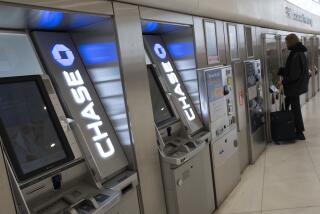Banks, Thrifts at Dagger Points Over Deposit Insurance Proposal : Finance: S&L; industry tells regulators at hearing that FDIC plan to cut bank payments would mean its demise.
- Share via
WASHINGTON — Banking industry officials insisted Friday that regulators should proceed with a proposal to reduce bank payments by $4.4 billion to the federal fund that insures their deposits.
But savings and loan associations told a regulatory hearing here that they could be driven into extinction if they must pay substantially more for deposit protection than their bank competitors.
The strong disagreements between banking and thrift industry leaders, at a hearing conducted by the Federal Deposit Insurance Corp., dramatized for the first time in a public forum the deep divisions between the two sectors over the issue of reduced deposit insurance premiums. The premiums support the federal deposit insurance system that insures customers’ deposits up to $100,000.
The proposed reduction in banks’ premiums to the FDIC is made possible because the insurance fund has met a goal of 1.25% of deposits. But thrifts cannot have a similar reduction in their insurance fund, because it has not reached the same solvency standard required under federal law. A large share of thrift payments have gone to paying for bonds for the S&L; cleanup.
Thrifts contend that allowing a huge reduction in banks’ premiums would make thrifts non-competitive. Accordingly, several of the nation’s most prominent thrifts have indicated they will seek bank charters if regulators decided to slash the bank insurance premiums.
“It’s a survival issue for many of us,” said James Montgomery, chairman of Chatsworth-based Great Western Financial Corp., which would save $55 million by shifting to a bank charter. Other thrifts applying for a bank charter include Irwindale-based H. F. Ahmanson & Co., parent of Home Savings of America, and Los Angeles-based California Federal Bank.
Thrifts would be driven into a “death spiral” if banks paid far less for deposit insurance, warned Joe C. Morris, an S&L; president from Kansas and head of a thrift industry advisory committee.
The comment drew a strong negative response from bankers, who said they already paid billions to rebuild their insurance fund.
“I have a hard time seeing how my customers and my employees should pay for the S&L; problem,” said R. Scott Grigsby, representing the American Bankers Assn., which wants deposit insurance premiums reduced this year.
Grigsby and other bankers said, in effect: we have already paid for our fund, there is no immediate crisis for the thrifts, and if there is a problem, it’s not our business.
The thrifts’ reply was equally strong: we can’t live with banks having such a huge advantage, and we’ll find a way to get around it, even if that means becoming banks and deserting our industry’s fund.
The two industries right now are far from a solution.
The FDIC has proposed a cut in banks’ insurance premium, now 23 cents per $100 of deposits for the strongest banks and thrifts. The rate would drop to 4 cents for the best-rated banks, about 90% of the 11,000 banks with federal deposit insurance. Bank premium payments would drop from an estimated $5.3 billion to approximately $920 million.
Banks could offer a higher deposit rate, nearly 0.2 percentage points on savings certificates, or a 0.2 percentage point reduction in loan rates. If thrifts tried to match banks, the additional spending of $4.4 billion would wipe out most of their profits, which totaled $6 billion last year, according to Robert R. Davis, chief economist for America’s Community Bankers, the thrift trade association.
Wearing two figurative hats at the meeting, Great Western chief Montgomery proposed on behalf of the Western League of Financial Institutions a merger of the bank and thrift insurance funds to retain the same premium level for both industries. But this would enrage bankers, who regard it as a diversion of their money to the benefit of the thrifts.
Montgomery offered a less-radical plan in his role as first vice chairman of America’s Community Bankers. The ACB plan calls for a much smaller differential between banks and thrifts, 9 cents per $100 for thrifts and 4 cents for banks as proposed by the FDIC. The banks would be asked to help pay for the federal bonds used in the S&L; cleanup, and some $14 billion in unused funds appropriated by Congress for disposing of defunct S&Ls; would be used to cover the cost of future thrift failures.
More to Read
Inside the business of entertainment
The Wide Shot brings you news, analysis and insights on everything from streaming wars to production — and what it all means for the future.
You may occasionally receive promotional content from the Los Angeles Times.










